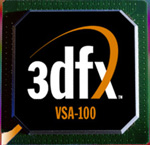3dfx Voodoo4 / Voodoo5 Comdex 99 Preview
by Mike Andrawes on November 19, 1999 10:50 PM EST- Posted in
- Systems
 3dfx
quietly stole the limelight once again at this year’s fall Comdex in Las Vegas.
From the wax museum in the Venetian, 3dfx announced the first implementation
of the Voodoo Scalable Architecture with the VSA-100. We all expected a fill
rate monster out of 3dfx and the products they announced based on the VSA-100
managed to fulfill every last one of our expectations.
3dfx
quietly stole the limelight once again at this year’s fall Comdex in Las Vegas.
From the wax museum in the Venetian, 3dfx announced the first implementation
of the Voodoo Scalable Architecture with the VSA-100. We all expected a fill
rate monster out of 3dfx and the products they announced based on the VSA-100
managed to fulfill every last one of our expectations.
The VSA-100, as you can probably already gather, is the basis for quite a few products. Much like the Voodoo3 was the core behind the Voodoo3 graphics cards, the VSA-100 is the heart and soul of 3dfx’s newly announced Voodoo4 and Voodoo5 products. Let’s first start with the VSA-100 specifications:
The VSA-100 will operate at somewhere between 333 and 367 megapixels/s, putting the actual clock speed at somewhere in the 166MHz to 183MHz range while rendering two pixels per clock. If you recall, this is essentially a Voodoo3 3000 or a 3500.
The VSA-100 adds support for 32-bit color rendering, 32-bit textures, 32/24-bit Z & W, and an 8-bit stencil buffer. Furthermore, the VSA-100 can also render two single-textured pixels per clock or one dual-textured pixel per clock. Support for 2K x 2K textures has now been implemented into the VSA-100, thus the VSA-100 offers essentially everything the Voodoo3 lacked and was criticized for tremendously.
The chip is an AGP 4X part, with support for AGP 2X, AGP 1X and PCI operating modes. In spite of this the VSA-100 does not support AGP texturing. 3dfx still feels that AGP texturing is not truly beneficial and thus there is no reason to pursue support for it with their products. The chip itself is composed of 14 million transistors, a little more than half the count of the GeForce, and is manufactured on an enhanced 0.25-micron, 6-layer metal process. The "enhanced" 0.25-micron process just means that it takes advantage of shorter gate lengths, which allow for faster switching thus allowing for higher frequencies and greater yields at those frequencies. According to 3dfx, the 0.18-micron process is not a mature one and thus they felt that they would achieve higher yields on a more mature 0.25-micron process. For reference purposes, the only true 0.18-micron graphics chip available is the mobile Savage MX from S3, with the Savage 2000 being a hybrid 0.18/0.22-micron solution.
The VSA-100 supports all T-Buffer effects, Full Screen Antialiasing, FXT1/DXTC texture compression and all of the other features 3dfx has been talking about for the past few months. For more information on those technologies read our coverage of them here.
The VSA-100 supports anywhere from 4MB to 64MB of memory per chip, whose clock is synchronized with the core clock, just like the Voodoo3. The memory bus is 128-bits wide and will offer anywhere between 2.7GB/s and 2.9GB/s worth of memory bandwidth depending on the final clock speed of the chip. The excellent 350MHz RAMDAC of the Voodoo3 is carried over to the VSA-100.
From the above description the VSA-100 doesn’t appear to be much more than a Voodoo3 with support for a few new visual features and 32-bit color rendering support, but the chip’s support for up to 32-way SLI scalability (hence the name Voodoo Scalable Architecture) is what truly defines it and sets it apart from the Voodoo3.










0 Comments
View All Comments